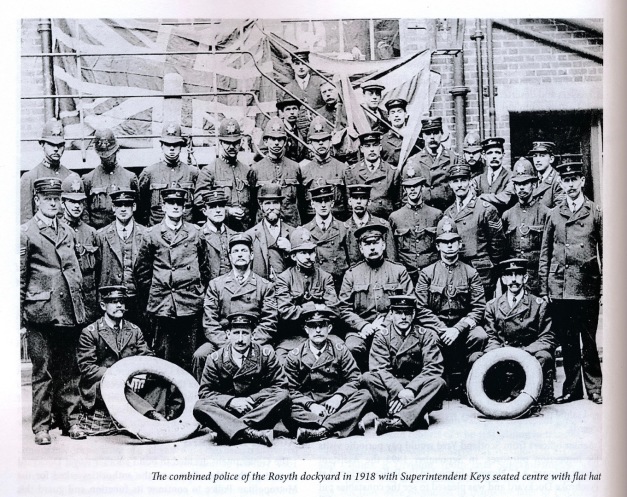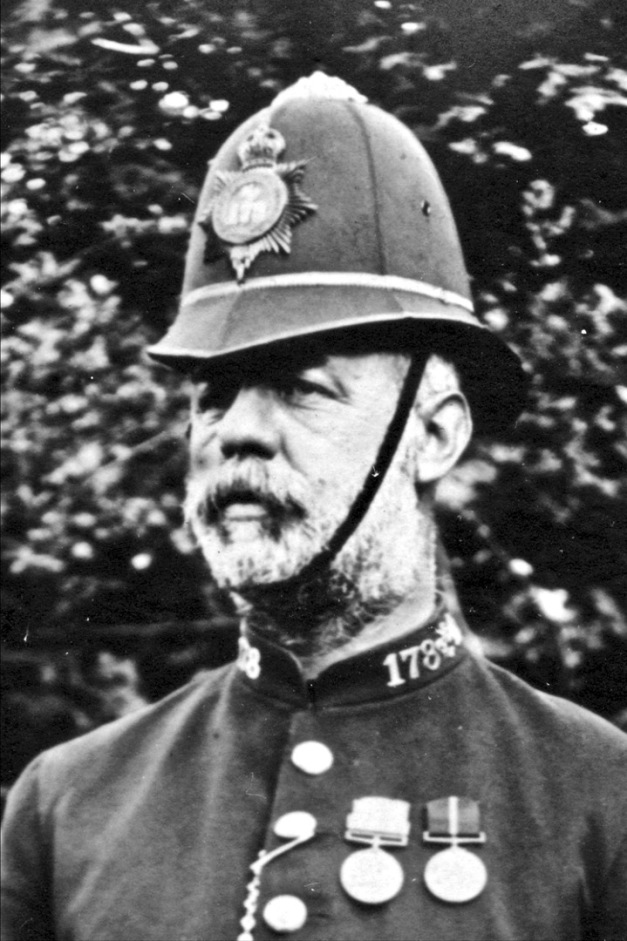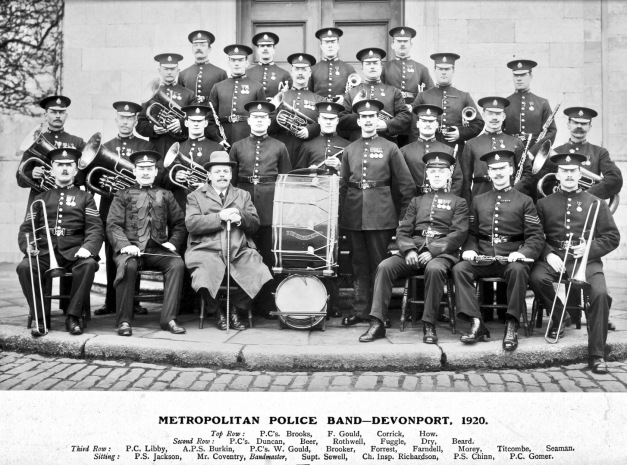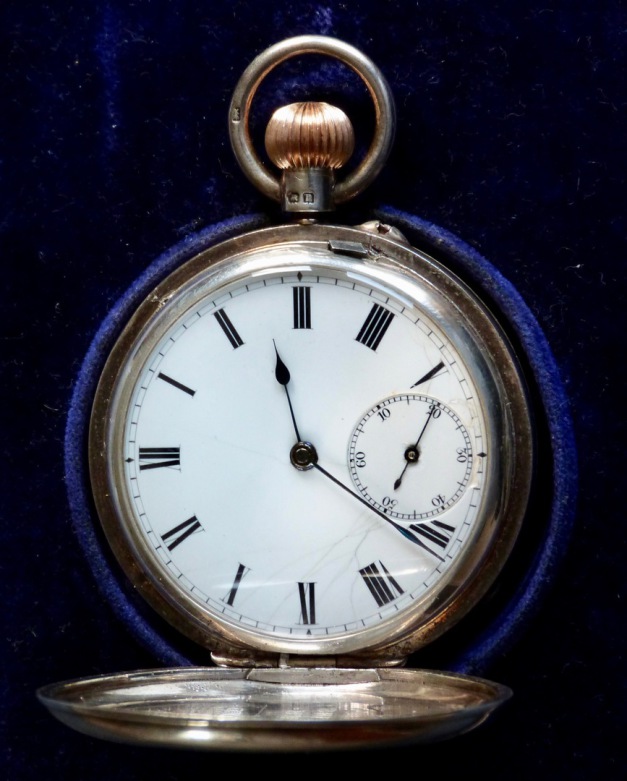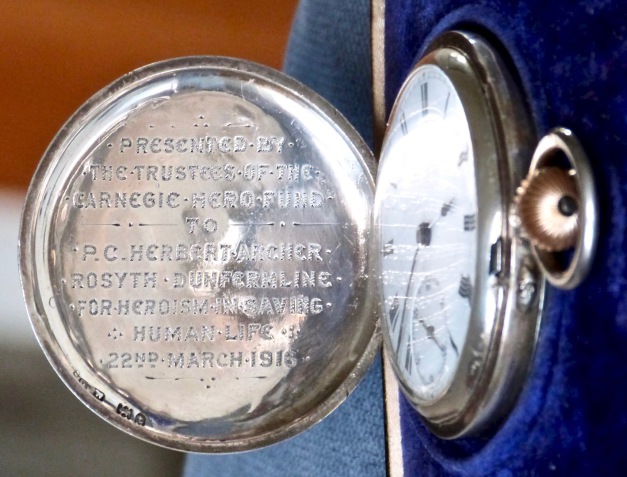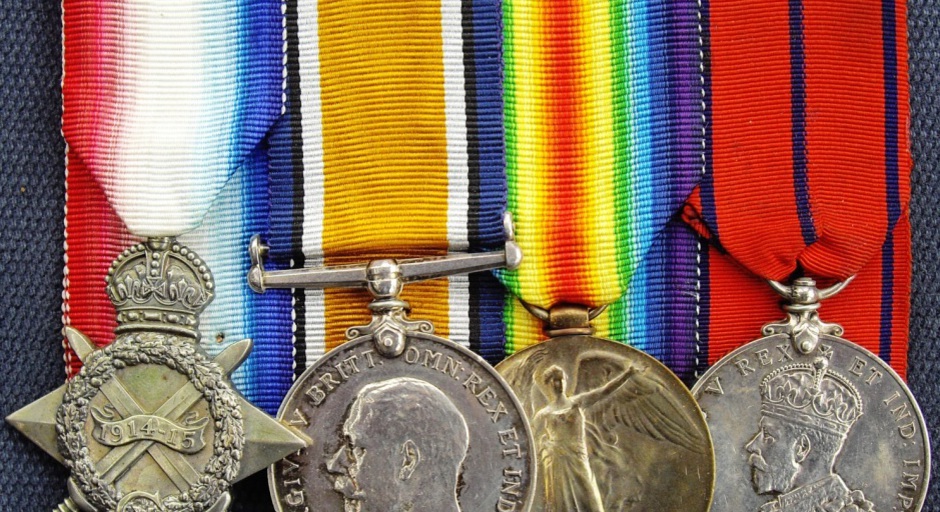
6th (Rosyth) Dockyard Division, Metropolitan Police
Police Constable Herbert Thomas Archer KPM
This article is concerned with a Metropolitan Police (MP) officer awarded the King’s Police Medal (KPM) for Gallantry in 1917. What makes it unusual is that the incident took place in Scotland at Rosyth Naval Dockyard. What follows is a brief description of why the MP was in Scotland followed by a description of the circumstances that led to PC Archer receiving the KPM, a Bronze Medal of the Royal Humane Society and a silver watch from The Carnegie Hero Trust Fund.
The Metropolitan Police and Naval Dockyards
The Metropolitan Police Act, 1860 authorised the employment of constables of the Metropolitan Police in naval dockyards and military yards in England and Wales. The dockyard divisions were designated by numbers rather than letters and until 1914, were as follows:
|
Designation |
Location |
|
1st Division. |
Woolwich Dockyard; Greenwich College; Deptford Victualling Yard; Powder Magazines and Railway Plant Depot, Plumstead Marshes. Arsenal. |
|
2nd Division. |
Portsmouth Dockyard; Gosport Victualling Yard; Haslar Naval Hospital; Gun Wharf, Portsmouth; Magazines, Priddy’s Hard; Magazine, Marchwood. |
|
3rd Division. |
Devonport Dockyard; Keyham Factory Yard; Stonehouse Victualling Yard; Stonehouse Naval Hospital; St George’s Hall, Stonehouse; Royal Magazines, Bull Point; Gun Wharf, Devonport. |
|
4th Division. |
Chatham Dockyard; Sheerness Dockyard; Royal Naval Hospital; Chatham Gun Wharf; Upper Powder Magazine; Sheerness Gun Wharf; Powder Magazine, Chattenden; Gun Wharf, Dover; Submarine Mining Establishment, Field Park, Chatham; Field Park, Upnor. |
|
5th Division. |
Pembroke Dockyard. [i] |
The officers stationed at the dockyards were responsible for the armed security of the entire operation. Their uniform was the same as other Metropolitan Police officers with the addition of a small fouled anchor in place of a divisional letter on the helmet plate and the collar number. They also maintained a Dockyard Fire Brigade.
[i] Index to the Police Forces of the British Empire and the United States of America, F. J. Kirchner, Manchester, 1893.
The Royal Naval Dockyard Rosyth, Scotland
In the early 20th century, as war with Imperial Germany became more likely, Britain responded by building bigger battleships known as ‘Dreadnoughts’. The Admiralty decided that existing bases in Portsmouth and Plymouth were too far from the potential battleground in the North Sea and decided to look for suitable sites in Scotland.
Rosyth is situated in the County of Fife on the north bank of the River Forth to the west of the Victorian Forth Rail Bridge and the Firth of Forth Estuary and strategically placed for access to the North and Baltic Seas. Invergordon, Ross and Cromarty, is on the Cromarty Firth, a deep but sheltered sea-loch in the north-east of Scotland with easy access to the North Sea.
The Royal Navy purchased land in Rosyth between 1906 and 1909 and construction began in 1911.
The original scheme involved a large deep-water basin that ships would enter using a lock. In addition, there were to be two dry-docks and space for a third. The dockyard was set to cover 1200 acres with a waterfront of 2.5 miles (4 km). The dockyard was also due to have a tidal basin, an inlet that empties or fills as the tide ebbs and flows.
The civil engineering firm Easton Gibb & Son were contracted to construct the dockyard but soon became involved in differences of opinion with the Admiralty on how it should be constructed. The Project Engineer, Alexander Gibb wanted to build a cofferdam. [i]
After three years with the sea-wall still incomplete, the Admiralty admitted defeat and allowed the engineers to construct the cofferdams. The dockyard finally opened in March 1916 with the battleship HMS Zealandia the first to use the base. [ii]
The Metropolitan Police Act, 1860
In 1914, the Metropolitan Police Act, 1860 was extended to allow the employment of Metropolitan Police Constables in Naval yards in Scotland in a similar manner to that in England and Wales. The expression ‘yard’ included ‘any other naval establishments’ in Scotland.
Transfers to Rosyth from Other Metropolitan Police Establishments
In a letter to the Commissioner Sir Edward Henry dated 30 December 1915, ‘E. Blackwell’ of the Home Office confirmed the authority for the employment of ‘two Inspectors, eight Sergeants and seventy-two Constables at three Naval Establishments ‘recently formed in Scotland’.
Sir,
In reply to your letter (616908/57) of the 22nd instant with reference to the application by the Admiralty for Metropolitan Police Officers for duty at three Naval establishments recently formed in Scotland, the numbers asked for being as follows:-
|
|
Inspectors |
Sergeants |
Constables |
|
Rosyth |
1. |
4. |
32. |
|
Crombie |
1. |
3. |
28. |
|
Invergordon |
- |
1. |
12. |
I am directed by the Secretary of State to convey to you hereby, covering authority for the employment of the two Inspectors, eight Sergeants and seventy-two Constables whose services have been applied for and who, with the exception of three Constables for Rosyth, have already taken up their duties, and to say that the Secretary of State sanctions the payment of the special allowance of 1/- per diem to the Sergeant and twelve Constables stationed at Invergordon, this allowance having been approved by the Admiralty in view of the special nature of the duties.
The Secretary of State also sanctions the formation of the proposed new Police division, to be known as Rosyth Dockyard Division, and the augmentation of the Force by one Chief Inspector and one Constable to act as Divisional Clerk; the Chief Inspector to be paid the usual lodging allowance of 2/6d a day, provided that the cost is borne by the Admiralty.
I am Sir,
Your obedient Servant,
(Signed) E. Blackwell.”
PC Herbert Thomas Archer
Herbert Thomas Archer was born in 1891 in Rugby, Warwickshire. He was a House Painter before he joined the Metropolitan Police on 18 December 1911 with the Warrant Number 100867. He was posted to Southwark District (M) as PC 488 M.
Police Orders of Wednesday 25 June 1913 show his transfer from Southwark to Devonport (3rd Division) as PC 238.
With the creation of the new Royal Dockyard, it was decided to transfer officers from the other Dockyard and Territorial Divisions and men were transferred to a holding post in the Commissioner’s Office (CO). The Police Orders of Thursday 30 December 1915 announced the constitution of Rosyth Dockyard, Crombie Naval Ordnance Depot and Invergordon Repair Depot, in Scotland as a separate Dockyard Division ‘under a Chief Inspector, from the 1st proximo and will be known as Rosyth Dockyard or 6th Division.’
Thus Chief Inspector Henry Daniel Morgan was transferred from Pembroke to Rosyth with effect from 1stDecember 1915. On the same date, 2 Inspectors, 8 Police Sergeants and 69 Police Constables were transferred from CO for duty at Rosyth.[1] PC Herbert Thomas Archer became PC 86 at Rosyth. The 6thDivision subsequently had outposts at Port Edgar, across the river at South Queensferry, Crombie Point, further west on the same coast, Invergordon on the Cromarty Firth in Ross and Cromarty and at the Armaments Depot at Polmaise,(RN Bandeath) near Stirling.
The dockyard was a huge building site with thousands of itinerant workers housed nearby in huts. The construction services included at least 40 railway locomotives transporting heavy materials and there was constant need to guard against crime, disorder and espionage. Especially during the war, there was tension as more and more local men were conscripted and their jobs taken by the incomers. It was a tense place to work and few opportunities to break the routine. The officers were paid a small per diem allowance for their ‘detached service’ but they still had to endure difficult working conditions.
Herbert Archer had only been at Rosyth just under three months when an incident took place in which he demonstrated outstanding bravery that was to be recognised by three different institutions.
[1] I have a full list of the 6th Division officers from 1915 – 1926. Please contact me via www.scottishpolicemedals.co.uk for further details.
[i] Cofferdam = an enclosure built within, or in pairs across, a body of water to allow the enclosed area to be pumped out. The pumping creates a dry working environment so that construction can be carried out safely. Enclosed coffers were commonly used in the construction or repair of piers, dams built over water. https://en.wikipedia.org/wiki/Cofferdam
[ii] https://www.ice.org.uk/what-is-civil-engineering/what-do-civil-engineers-do/rosyth-dockyard
The Rescue of a Child from the Caisson at Rosyth Dockyard, 22 March 1916
A report in ‘The Evening News’ of Friday 14 April records the following under the heading “Gallantry Recognised, Royal Humane Society”:
“At the monthly meeting of the Royal Humane Society, held on Tuesday,[i] Admiral Sir G. D. Morant presiding, the following awards were made for gallant action in saving or attempting to save life:-
…Bronze Medal to Herbert Archer, constable Metropolitan Police, stationed at Rosyth, for heroic action on March 22nd in saving a lad from a caisson at the dockyard there. Although Archer knew there was no means of getting out, he dropped into the caisson, which contained 37ft of water, and supported the lad till help was summoned and they were pulled out”. [ii]
The Presentation of the Bronze Medal of the Royal Humane Society
The Dunfermline Express of 16 May 1916[iii] carried perhaps the clearest report of all the circumstances that lead to PC Archer receiving the three awards for bravery. The article on page 2 under the headline “THE NAVAL BASE” – “Reward for Bravery”, is quoted in full below:
“An interesting ceremony took place at Rosyth Dockyard on Wednesday afternoon,[iv] when Police Constable Herbert Archer of the Metropolitan Police was presented with a bronze medal and certificate of the Royal Humane Society for conspicuous bravery in rescuing a young lad from drowning. The presentation was made by Commodore Harvey H. Bruce, MVO, RN, who was introduced by Chief Inspector Morgan of the Metropolitan Police. Accompanying the Commodore were Mr Alexander Gibb, dockyard contractor and Mr Stanley Cooke, the dockyard secretary. A contingent of about 20 officers and men of the Metropolitan Police was also in attendance. The details of the act of bravery are as follows:-
At about 5.20 am on 22nd March 1916,which was a very dark, cold morning, a lad of 14, named Thomas Surrell, residing with his parents at No. 17 Hut, Rosyth Village, and employed by Messrs Easton Gibb & Son, Ltd., was crossing a caisson at the dockyard when he slipped and fell into about 37 feet of water. Another lad shouted for help, and Police Constable Archer, who was on duty near at hand, ran to the spot and throwing off his greatcoat and helmet, jumped about 10 feet into the water. After successfully locating the boy in the darkness, he supported him until a rope was lowered from above. The lad above was unable to hold the weight of the two who were in the water, and Police Constable Archer, therefore, swam with the boy to the end of the caisson, and held on by the stonework until further assistance was secured. Police Constable Archer ran great risk of injuring himself by striking the steelwork of the caisson when he jumped into the water in the darkness, and he had great difficulty in saving the boy, who could not swim, and thus impeded his movements.
Commodore Bruce, in making the presentation, expressed his appreciation of the gallant action of Constable Archer, which had been performed under circumstances of extreme danger. But for such prompt and heroic action, the lad Surrell would undoubtedly have been drowned . He was always glad to see bravery recognised and was proud to shake hands with Constable Archer as a brave man and trusted that he would long be spared to wear the Royal Humane Society’s medal.
Constable Archer briefly thanked the Commodore for his kind words, and modestly expressed the hope that when duty called he would always be ready to answer. He also thanked Chief Inspector Morgan for his kindness in bringing the case for recognition.
Mr Alexander Gibb was also cordially thanked for the interest he had manifested in the case, and for bringing the Constable’s bravery before the notice of the Carnegie Hero Fund Trust. Chief Inspector Morgan moved a vote of thanks to Commodore Bruce for his courtesy in making the presentation, and for the assistance he had given in securing some tangible recognition of Constable Archer’s brave action.”
The Carnegie Hero Fund
An article appeared in the ‘Daily Record and Mail Friday 26 May 1916’ and reported the following under the heading ‘Carnegie Heroes’:
“The monthly meeting of the Trustees of the Carnegie Hero Fund was held at Dunfermline yesterday – Dr John Rose (sic)[v], the chairman presiding. Following is a list of the awards for May:-
Constable Herbert Archer Metropolitan Police Force, Rosyth Dockyard Division, on 22nd March 1916, rescued a boy from drowning in a caisson chamber at Rosyth. The incident took place about 5.a.m., while it was yet dark. The water was about 40 feet deep. The constable was awarded a silver watch with suitable inscription, and the sum of £10”. [vi]
Inscription on Carnegie Hero Fund Watch
“Presented by The Trustees of the Carnegie Hero Fund
To
P. C. Herbert Archer
Rosyth, Dunfermline,
For heroism in saving human life.
22nd March 1916.”
It is not recorded who actually recommended PC Archer for the award, but the correspondence originated from Easton Gibb & Son, the Chairman of whom, was Alexander Gibb.
The Surrell Family in Rosyth
The boy whom Herbert Archer saved from the caisson was Thomas Surrell, born 28 March 1901 in Chipping Sodbury, Gloucestershire. His parents, Thomas, an Engine Driver,
Isabella his mother, and his three sisters were living at No. 17 Hut, Rosyth Village.
When the Admiralty awarded the contract to build the dockyard, Easton Gibb & Son bought up a number of sand and stone quarries in the Fife area and employed in excess of 3500 men to build the necessary structures. Easton Gibb & Son negotiated a branch line of the North British Railway (NBR) Inverkeithing to North Queensferry line and Thomas (senior) drove one of the forty plus locomotives that moved building material from around Fife to the dockyard site.[vii] His son was also working in some capacity in the dockyard.
Thomas (junior) married in Kent in 1934. By the 1939 Register, he, was an ‘Engine Driver in a Cement Works’ and living in Dartford.
The couple lived in Kent for the rest of their married life. His wife died aged 51 in Dartford in 1956. Thomas died in Gravesend aged 87 in 1988.
The King’s Police Medal for Gallantry
The London Gazette of 12 February 1917 published the award of the King’s Police Medal (KPM) for Gallantry to Constable Herbert Archer of the Metropolitan Police. PC Archer was presented with his KPM on 2 May 1917 by Rear Admiral Harvey H Bruce CB, MVO, Admiral Superintendent at Rosyth Dockyard.
The King’s Police Medal originally had a ribbon of deep blue with silver edges and the words ‘To guard my people’ on the reverse, but in 1916, a central silver stripe was added. From 1933, the award ‘for Distinguished Conduct’ had three silver and two blue stripes. The award ‘For Gallantry’ was distinguished by the three thin red stripes through the silver. As well as the three thin red stripes, the words ‘For Gallantry’ were on the reverse exergue.
[i] Author’s Note Thursday 13 April 1916.
[ii] The Evening News, Friday April 14, 1916.
[iii] The Dunfermline Express, Tuesday 16 May 1916, page 2.
[iv] Author’s Note, Wednesday 15 May 1916.
[v] Correct name is Dr John Ross.
[vi] The Daily Record and Mail, Friday 26 May 1916.
[vii] Industrial Locomotive Society Records, enquiries@industrial-loco.org.uk
Life after 1917
Herbert Archer married Mary Galbreath in Dunfermline in 1920 and they later had a son, George.
After the end of the First World War, the need for Rosyth Dockyard receded and in an effort to cut costs, the Admiralty proposed that the Royal Marine Police become responsible for the security of the naval stations in Scotland. In Police Orders of Monday 23 April 1923, along with 1 Superintendent, 1 Inspector, 3 Police Sergeants and 29 other Constables, PC Herbert was transferred back to the Metropolitan Police District in London. From Monday 30 April 1923, his collar number was PC 700 V at Wandsworth.
PC Herbert Archer continued to serve in Wandsworth until 21 December 1937 when he retired on pension aged 46. His conduct was considered ‘Exemplary’.[i]
The Register of England & Wales, 1939
The 1939 Register records that Herbert Archer, his wife Mary, their son George and his mother in law, Mary Newson, were living at 122 South Park Road, Wimbledon, Surrey.[ii]
The End of the Story
Herbert Thomas Archer, (92) of 171 Engadine Street, Southfields London SW18 died on 5 June 1983. [iii]
Mary McLeod Archer, (90), born 6 April 1900, died in Croydon in March 1991. [iv]
George Herbert Archer, (92) born 27 October 1920, died in Worcester Park, Surrey on 19 March 2012. [v]
I bought the Carnegie Hero Fund inscribed silver watch in a recent Dix Noonan Webb auction.
This is the first time I have researched a Metropolitan Police Dockyard Division officer and as ever, it has been a steep learning curve. I found several national newspaper articles mentioning the awards but the content in each was very similar. I decided to try the local newspapers and it was in those that I found the most detailed description of the events of 22 March 1916. My thanks to the staff of the Reading Room of the Carnegie Library, Dunfermline for their patience and assistance. My thanks also to Russell Wear of the Industrial Locomotives Society. A special thank you to Ray Rickets for his generosity in letting me use the images of Metropolitan Police Dockyard officers.
I would be interested in finding the location of Herbert Archer’s KPM and his RHS bronze medal and especially in obtaining pictures of both inscriptions on the rims of the medals. If you have any information, please feel free to contact me.
[i] MEPO 4/350 page 1, TNA.
[ii] RG101/1403E/005/38 Letter Code: CNPW Findmypast Ltd.
[iii] England & Wales National Probate Calendar (Index of Wills & Administrations), 1983, Ancestry.co.uk.
[iv] England & Wales , Civil Registration Death Index, 1916 – 2007, Ancestry.co.uk.
[v] England & Wales , Civil Registration Death Index, 1989 – 2018, Ancestry.co.uk
